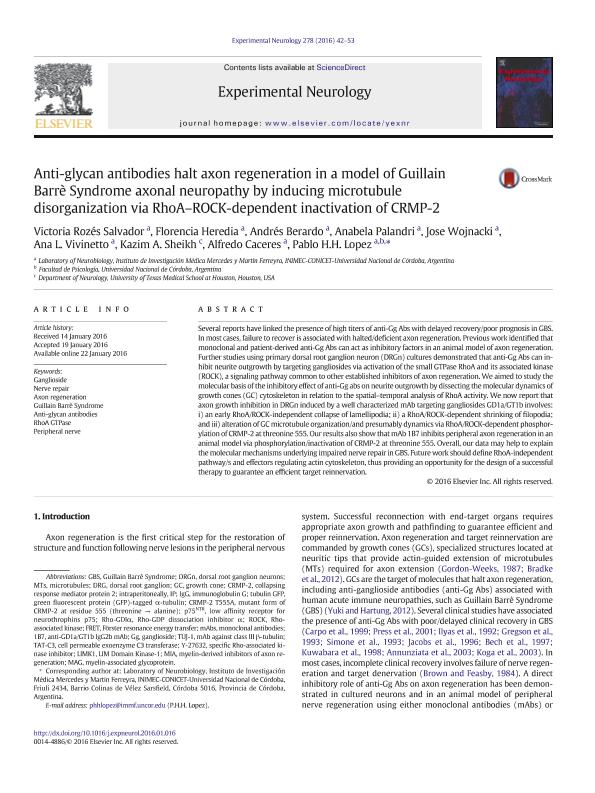Artículo
Anti-glycan antibodies halt axon regeneration in a model of Guillain Barrè Syndrome axonal neuropathy by inducing microtubule disorganization via RhoA-ROCK-dependent inactivation of CRMP-2
Rozés Salvador, María Victoria ; Heredia, María Florencia
; Heredia, María Florencia ; Berardo, Andrés; Palandri, Anabela
; Berardo, Andrés; Palandri, Anabela ; Wojnacki Fonseca, José Ignacio
; Wojnacki Fonseca, José Ignacio ; Vivinetto, Ana Laura
; Vivinetto, Ana Laura ; Sheikh, Kazim A.; Caceres, Alfredo Oscar
; Sheikh, Kazim A.; Caceres, Alfredo Oscar ; Lopez, Pablo
; Lopez, Pablo
 ; Heredia, María Florencia
; Heredia, María Florencia ; Berardo, Andrés; Palandri, Anabela
; Berardo, Andrés; Palandri, Anabela ; Wojnacki Fonseca, José Ignacio
; Wojnacki Fonseca, José Ignacio ; Vivinetto, Ana Laura
; Vivinetto, Ana Laura ; Sheikh, Kazim A.; Caceres, Alfredo Oscar
; Sheikh, Kazim A.; Caceres, Alfredo Oscar ; Lopez, Pablo
; Lopez, Pablo
Fecha de publicación:
04/2016
Editorial:
Academic Press Inc Elsevier Science
Revista:
Experimental Neurology
ISSN:
0014-4886
Idioma:
Inglés
Tipo de recurso:
Artículo publicado
Clasificación temática:
Resumen
Several reports have linked the presence of high titers of anti-Gg Abs with delayed recovery/poor prognosis in GBS. In most cases, failure to recover is associated with halted/deficient axon regeneration. Previous work identified that monoclonal and patient-derived anti-Gg Abs can act as inhibitory factors in an animal model of axon regeneration. Further studies using primary dorsal root ganglion neuron (DRGn) cultures demonstrated that anti-Gg Abs can inhibit neurite outgrowth by targeting gangliosides via activation of the small GTPase RhoA and its associated kinase (ROCK), a signaling pathway common to other established inhibitors of axon regeneration. We aimed to study the molecular basis of the inhibitory effect of anti-Gg abs on neurite outgrowth by dissecting the molecular dynamics of growth cones (GC) cytoskeleton in relation to the spatial-temporal analysis of RhoA activity. We now report that axon growth inhibition in DRGn induced by a well characterized mAb targeting gangliosides GD1a/GT1b involves: i) an early RhoA/ROCK-independent collapse of lamellipodia; ii) a RhoA/ROCK-dependent shrinking of filopodia; and iii) alteration of GC microtubule organization/and presumably dynamics via RhoA/ROCK-dependent phosphorylation of CRMP-2 at threonine 555. Our results also show that mAb 1B7 inhibits peripheral axon regeneration in an animal model via phosphorylation/inactivation of CRMP-2 at threonine 555. Overall, our data may help to explain the molecular mechanisms underlying impaired nerve repair in GBS. Future work should define RhoA-independent pathway/s and effectors regulating actin cytoskeleton, thus providing an opportunity for the design of a successful therapy to guarantee an efficient target reinnervation.
Archivos asociados
Licencia
Identificadores
Colecciones
Articulos(INIMEC - CONICET)
Articulos de INSTITUTO DE INV. MEDICAS MERCEDES Y MARTIN FERREYRA
Articulos de INSTITUTO DE INV. MEDICAS MERCEDES Y MARTIN FERREYRA
Citación
Rozés Salvador, María Victoria; Heredia, María Florencia; Berardo, Andrés; Palandri, Anabela; Wojnacki Fonseca, José Ignacio; et al.; Anti-glycan antibodies halt axon regeneration in a model of Guillain Barrè Syndrome axonal neuropathy by inducing microtubule disorganization via RhoA-ROCK-dependent inactivation of CRMP-2; Academic Press Inc Elsevier Science; Experimental Neurology; 278; 4-2016; 42-53
Compartir
Altmétricas



